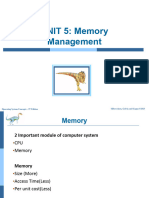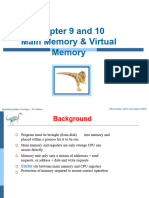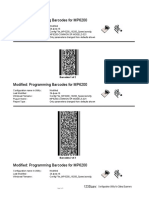Chapter 9: Main Memory
Dr. Shadi Banitaan
Operating System Concepts – 10th Edition Silberschatz, Galvin and Gagne ©2018
Chapter 9: Memory Management
Background
Contiguous Memory Allocation
Paging
Structure of the Page Table
Swapping
Operating System Concepts – 10th Edition 9.2 Silberschatz, Galvin and Gagne ©2018
Objectives
To provide a detailed description of various ways of organizing memory
hardware
To discuss various memory-management techniques
Operating System Concepts – 10th Edition 9.3 Silberschatz, Galvin and Gagne ©2018
Background
Program must be brought (from disk) into memory and placed within a
process for it to be run
Main memory and registers are only storage CPU can access directly
Register access is done in one CPU clock (or less)
Main memory can take many cycles, causing a stall
Cache sits between main memory and CPU registers
Protection of memory required to ensure correct operation
Operating System Concepts – 10th Edition 9.4 Silberschatz, Galvin and Gagne ©2018
Protection
Need to ensure that a process can access only those addresses in
its address space.
We can provide this protection by using a pair of base and limit
registers define the logical address space of a process
Operating System Concepts – 10th Edition 9.5 Silberschatz, Galvin and Gagne ©2018
Hardware Address Protection
CPU must check every memory access generated in user mode to
be sure it is between base and limit for that user
The instructions to load the base and limit registers are privileged
Operating System Concepts – 10th Edition 9.6 Silberschatz, Galvin and Gagne ©2018
Address Binding
Addresses represented in different ways at different stages of a
program’s life
• Source code addresses usually symbolic
• Compiled code addresses bind to relocatable addresses
i.e., “14 bytes from beginning of this program”
• Linker or loader will bind relocatable addresses to absolute
addresses
i.e., 74014
• Each binding maps one address space to another
Operating System Concepts – 10th Edition 9.7 Silberschatz, Galvin and Gagne ©2018
Binding of Instructions and Data to Memory
Address binding of instructions and data to memory addresses can
happen at three different stages
• Compile time: If memory location known a priori, absolute code
can be generated; must recompile code if starting location
changes
• Load time: Must generate relocatable code if memory location
is not known at compile time
• Execution time: Binding delayed until run time if the process can
be moved during its execution from one memory segment to
another
Need hardware support for address maps (e.g., base and limit
registers)
Operating System Concepts – 10th Edition 9.8 Silberschatz, Galvin and Gagne ©2018
Multistep Processing of a User Program
Operating System Concepts – 10th Edition 9.9 Silberschatz, Galvin and Gagne ©2018
Logical vs. Physical Address Space
The concept of a logical address space that is bound to a separate
physical address space is central to proper memory management
• Logical address – generated by the CPU; also referred to as
virtual address
• Physical address – address seen by the memory unit
Logical and physical addresses are the same in compile-time and load-
time address-binding schemes; logical (virtual) and physical addresses
differ in execution-time address-binding scheme
Logical address space is the set of all logical addresses generated
by a program
Physical address space is the set of all physical addresses
generated by a program
Operating System Concepts – 10th Edition 9.10 Silberschatz, Galvin and Gagne ©2018
Memory-Management Unit (MMU)
Hardware device that at run time maps virtual to physical address
Operating System Concepts – 10th Edition 9.11 Silberschatz, Galvin and Gagne ©2018
Memory-Management Unit (Cont.)
Consider simple scheme. which is a generalization of the base-
register scheme.
The base register now called relocation register
The value in the relocation register is added to every address
generated by a user process at the time it is sent to memory
The user program deals with logical addresses; it never sees the real
physical addresses
• Execution-time binding occurs when reference is made to location
in memory
• Logical address bound to physical addresses
Operating System Concepts – 10th Edition 9.12 Silberschatz, Galvin and Gagne ©2018
Memory-Management Unit (Cont.)
Consider simple scheme. which is a generalization of the base-
register scheme.
The base register now called relocation register
The value in the relocation register is added to every address
generated by a user process at the time it is sent to memory
Operating System Concepts – 10th Edition 9.13 Silberschatz, Galvin and Gagne ©2018
Dynamic Loading
The entire program does need to be in memory to execute
Routine is not loaded until it is called
Better memory-space utilization; unused routine is never loaded
All routines kept on disk in relocatable load format
Useful when large amounts of code are needed to handle
infrequently occurring cases
No special support from the operating system is required
• Implemented through program design
• OS can help by providing libraries to implement dynamic
loading
Operating System Concepts – 10th Edition 9.14 Silberschatz, Galvin and Gagne ©2018
Contiguous Allocation
Main memory must support both OS and user processes
Limited resource, must allocate efficiently
Contiguous allocation is one early method
Main memory usually into two partitions:
• Resident operating system, usually held in low memory with
interrupt vector
• User processes then held in high memory
• Each process contained in single contiguous section of memory
Operating System Concepts – 10th Edition 9.15 Silberschatz, Galvin and Gagne ©2018
Contiguous Allocation (Cont.)
Relocation registers used to protect user processes from each other,
and from changing operating-system code and data
• Base register contains value of smallest physical address
• Limit register contains range of logical addresses – each logical
address must be less than the limit register
• MMU maps logical addresses dynamically
Operating System Concepts – 10th Edition 9.16 Silberschatz, Galvin and Gagne ©2018
Hardware Support for Relocation and Limit Registers
Operating System Concepts – 10th Edition 9.17 Silberschatz, Galvin and Gagne ©2018
Variable Partition
Multiple-partition allocation
• Degree of multiprogramming limited by number of partitions
• Variable-partition sizes for efficiency (sized to a given process’ needs)
• Hole – block of available memory; holes of various size are scattered
throughout memory
• When a process arrives, it is allocated memory from a hole large enough to
accommodate it
• Process exiting frees its partition, adjacent free partitions combined
• Operating system maintains information about:
a) allocated partitions b) free partitions (hole)
Operating System Concepts – 10th Edition 9.18 Silberschatz, Galvin and Gagne ©2018
Dynamic Storage-Allocation Problem
How to satisfy a request of size n from a list of free holes?
First-fit: Allocate the first hole that is big enough
Best-fit: Allocate the smallest hole that is big enough; must
search entire list, unless ordered by size
• Produces the smallest leftover hole
Worst-fit: Allocate the largest hole; must also search entire list
• Produces the largest leftover hole
First-fit and best-fit better than worst-fit in terms of speed and storage
utilization
Operating System Concepts – 10th Edition 9.19 Silberschatz, Galvin and Gagne ©2018
Fragmentation
External Fragmentation – total memory space exists to satisfy a
request, but it is not contiguous
Internal Fragmentation – allocated memory may be slightly larger
than requested memory; this size difference is memory internal to a
partition, but not being used
First fit analysis reveals that given N blocks allocated, 0.5 N blocks
lost to fragmentation
• 1/3 may be unusable -> 50-percent rule
Operating System Concepts – 10th Edition 9.20 Silberschatz, Galvin and Gagne ©2018
Fragmentation (Cont.)
Reduce external fragmentation by compaction
• Shuffle memory contents to place all free memory together in one
large block
• Compaction is possible only if relocation is dynamic and is done at
execution time
Operating System Concepts – 10th Edition 9.21 Silberschatz, Galvin and Gagne ©2018
Paging
Physical address space of a process can be noncontiguous;
process is allocated physical memory whenever the latter is
available
• Avoids external fragmentation
• Avoids problem of varying sized memory chunks
Divide physical memory into fixed-sized blocks called frames
• Size is power of 2, between 512 bytes and 16 Mbytes
Divide logical memory into blocks of same size called pages
Keep track of all free frames
To run a program of size N pages, need to find N free frames and
load program
Set up a page table to translate logical to physical addresses
Still have Internal fragmentation
Operating System Concepts – 10th Edition 9.22 Silberschatz, Galvin and Gagne ©2018
Address Translation Scheme
Address generated by CPU is divided into:
• Page number (p) – used as an index into a page table which
contains base address of each page in physical memory
• Page offset (d) – combined with base address to define the
physical memory address that is sent to the memory unit
page number page offset
p d
m -n n
• For given logical address space 2m and page size 2n
Operating System Concepts – 10th Edition 9.23 Silberschatz, Galvin and Gagne ©2018
Paging Hardware
Operating System Concepts – 10th Edition 9.24 Silberschatz, Galvin and Gagne ©2018
Paging Model of Logical and Physical Memory
Operating System Concepts – 10th Edition 9.25 Silberschatz, Galvin and Gagne ©2018
Paging Example
Logical address: n = 2 and m = 4. Using a page size of 4 bytes and
a physical memory of 32 bytes (8 pages)
Operating System Concepts – 10th Edition 9.26 Silberschatz, Galvin and Gagne ©2018
Paging -- Calculating internal fragmentation
Page size = 2,048 bytes
Process size = 72,766 bytes
35 pages + 1,086 bytes
Internal fragmentation of 2,048 - 1,086 = 962 bytes
Worst case fragmentation = 1 frame – 1 byte
On average fragmentation = 1 / 2 frame size
So small frame sizes desirable?
But each page table entry takes memory to track
Page sizes growing over time
• Solaris supports two page sizes – 8 KB and 4 MB
Operating System Concepts – 10th Edition 9.27 Silberschatz, Galvin and Gagne ©2018
Free Frames
Before allocation After allocation
Operating System Concepts – 10th Edition 9.28 Silberschatz, Galvin and Gagne ©2018
Implementation of Page Table
Page table is kept in main memory
• Page-table base register (PTBR) points to the page table
• Page-table length register (PTLR) indicates size of the page
table
In this scheme every data/instruction access requires two memory
accesses
• One for the page table and one for the data / instruction
The two-memory access problem can be solved by the use of a special
fast-lookup hardware cache called translation look-aside buffers
(TLBs) (also called associative memory).
Operating System Concepts – 10th Edition 9.29 Silberschatz, Galvin and Gagne ©2018
Translation Look-Aside Buffer
Some TLBs store address-space identifiers (ASIDs) in each
TLB entry – uniquely identifies each process to provide address-
space protection for that process
• Otherwise need to flush at every context switch
TLBs typically small (64 to 1,024 entries)
On a TLB miss, value is loaded into the TLB for faster access
next time
• Replacement policies must be considered
• Some entries can be wired down for permanent fast access
Operating System Concepts – 10th Edition 9.30 Silberschatz, Galvin and Gagne ©2018
Hardware
Associative memory – parallel search
P a ge # F ra m e #
Address translation (p, d)
• If p is in associative register, get frame # out
• Otherwise get frame # from page table in memory
Operating System Concepts – 10th Edition 9.31 Silberschatz, Galvin and Gagne ©2018
Paging Hardware With TLB
Operating System Concepts – 10th Edition 9.32 Silberschatz, Galvin and Gagne ©2018
Effective Access Time
Hit ratio – percentage of times that a page number is found in the TLB
An 80% hit ratio means that we find the desired page number in the
TLB 80% of the time.
Suppose that 10 nanoseconds to access memory.
• If we find the desired page in TLB then a mapped-memory access
take 10 ns
• Otherwise we need two memory access so it is 20 ns
Effective Access Time (EAT)
EAT = 0.80 x 10 + 0.20 x 20 = 12 nanoseconds
implying 20% slowdown in access time
Consider amore realistic hit ratio of 99%,
EAT = 0.99 x 10 + 0.01 x 20 = 10.1ns
implying only 1% slowdown in access time.
Operating System Concepts – 10th Edition 9.33 Silberschatz, Galvin and Gagne ©2018
Memory Protection
Memory protection implemented by associating protection bit with
each frame to indicate if read-only or read-write access is allowed
• Can also add more bits to indicate page execute-only, and so on
Valid-invalid bit attached to each entry in the page table:
• “valid” indicates that the associated page is in the process’ logical
address space, and is thus a legal page
• “invalid” indicates that the page is not in the process’ logical
address space
• Or use page-table length register (PTLR)
Any violations result in a trap to the kernel
Operating System Concepts – 10th Edition 9.34 Silberschatz, Galvin and Gagne ©2018
Valid (v) or Invalid (i) Bit In A Page Table
Operating System Concepts – 10th Edition 9.35 Silberschatz, Galvin and Gagne ©2018
Shared Pages
Shared code
• One copy of read-only (reentrant) code shared among processes
(i.e., text editors, compilers, window systems)
• Similar to multiple threads sharing the same process space
• Also useful for interprocess communication if sharing of read-write
pages is allowed
Private code and data
• Each process keeps a separate copy of the code and data
• The pages for the private code and data can appear anywhere in
the logical address space
Operating System Concepts – 10th Edition 9.36 Silberschatz, Galvin and Gagne ©2018
Shared Pages Example
Operating System Concepts – 10th Edition 9.37 Silberschatz, Galvin and Gagne ©2018
Structure of the Page Table
Memory structures for paging can get huge using straight-forward
methods
• Consider a 32-bit logical address space as on modern computers
• Page size of 4 KB (212)
• Page table would have 1 million entries (232 / 212)
• If each entry is 4 bytes each process 4 MB of physical address
space for the page table alone
Don’t want to allocate that contiguously in main memory
• One simple solution is to divide the page table into smaller units
Hierarchical Paging
Hashed Page Tables
Inverted Page Tables
Operating System Concepts – 10th Edition 9.38 Silberschatz, Galvin and Gagne ©2018
Hierarchical Page Tables
Break up the logical address space into multiple page tables
A simple technique is a two-level page table
We then page the page table
Operating System Concepts – 10th Edition 9.39 Silberschatz, Galvin and Gagne ©2018
Two-Level Paging Example
A logical address (on 32-bit machine with 4K page size) is divided into:
• a page number consisting of 20 bits
• a page offset consisting of 12 bits
Since the page table is paged, the page number is further divided into:
• a 10-bit page number
• a 10-bit page offset
Thus, a logical address is as follows:
where p1 is an index into the outer page table, and p2 is the
displacement within the page of the inner page table
Known as forward-mapped page table
Operating System Concepts – 10th Edition 9.40 Silberschatz, Galvin and Gagne ©2018
Address-Translation Scheme
Operating System Concepts – 10th Edition 9.41 Silberschatz, Galvin and Gagne ©2018
64-bit Logical Address Space
Even two-level paging scheme not sufficient
If page size is 4 KB (212)
• Then page table has 252 entries
• If two level scheme, inner page tables could be 210 4-byte entries
• Address would look like
• Outer page table has 242 entries or 244 bytes
• One solution is to add a 2nd outer page table
• But in the following example the 2nd outer page table is still 234
bytes in size
And possibly 4 memory access to get to one physical memory
location
Operating System Concepts – 10th Edition 9.42 Silberschatz, Galvin and Gagne ©2018
Three-level Paging Scheme
Operating System Concepts – 10th Edition 9.43 Silberschatz, Galvin and Gagne ©2018
Hashed Page Tables
Common in address spaces > 32 bits
The virtual page number is hashed into a page table
• This page table contains a chain of elements hashing to the same
location
Each element contains (1) the virtual page number (2) the value of the
mapped page frame (3) a pointer to the next element
Virtual page numbers are compared in this chain searching for a
match
• If a match is found, the corresponding physical frame is extracted
Variation for 64-bit addresses is clustered page tables
• Similar to hashed but each entry refers to several pages (such as
16) rather than 1
• Especially useful for sparse address spaces (where memory
references are non-contiguous and scattered)
Operating System Concepts – 10th Edition 9.44 Silberschatz, Galvin and Gagne ©2018
Hashed Page Table
Operating System Concepts – 10th Edition 9.45 Silberschatz, Galvin and Gagne ©2018
Inverted Page Table
Rather than each process having a page table and keeping track of all
possible logical pages, track all physical pages
One entry for each real page of memory
Entry consists of the virtual address of the page stored in that real
memory location, with information about the process that owns that
page
Decreases memory needed to store each page table, but increases
time needed to search the table when a page reference occurs
Use hash table to limit the search to one — or at most a few — page-
table entries
• TLB can accelerate access
But how to implement shared memory?
• One mapping of a virtual address to the shared physical address
Operating System Concepts – 10th Edition 9.46 Silberschatz, Galvin and Gagne ©2018
Inverted Page Table Architecture
Operating System Concepts – 10th Edition 9.47 Silberschatz, Galvin and Gagne ©2018
End of Chapter 9
Dr. Shadi Banitaan
Operating System Concepts – 10th Edition Silberschatz, Galvin and Gagne ©2018
























































































